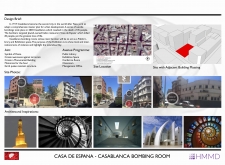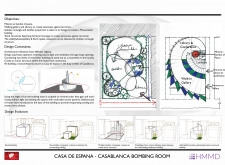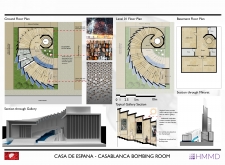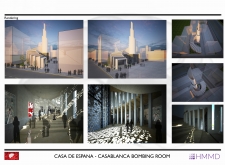5 key facts about this project
### Overview
The Casa de España - Casablanca Bombing Room is positioned in a significant urban context in Casablanca, Morocco, where it functions as both a public library and an exhibition space. The intent of the design is to address the city’s history of violence, particularly following the tragic bombing in 2003, by creating a site dedicated to peace, remembrance, and education. This architectural response seeks to establish a dialogue surrounding both local and global acts of violence, transforming the area into a focal point for community engagement.
### Spatial Composition
Located within a densely populated urban fabric, the building harnesses its monumental presence to create a distinct identity while harmonizing with its surroundings. A spiraling floor plan facilitates a natural flow throughout the various functional areas, including exhibition halls and classrooms, enhancing educational interaction and introspection. The architectural strategy employs large openings to optimize natural light and ventilation, promoting a welcoming environment conducive to contemplation and learning.
### Material Selection
The materials chosen for the project serve both aesthetic and functional purposes. Mushrabiah screens are incorporated to manage light and privacy, aligning with local cultural traditions and climatic responsiveness. Glazed walls enhance the building's transparency, fostering a connection between its interior and the external landscape. Additionally, the use of concrete as a primary structural element signifies resilience, while natural stone reflects environmental harmony and a timeless quality. These material decisions collectively embody the dual themes of strength and serenity, reinforcing the center’s purpose as a place of remembrance amid historical challenges.





















































